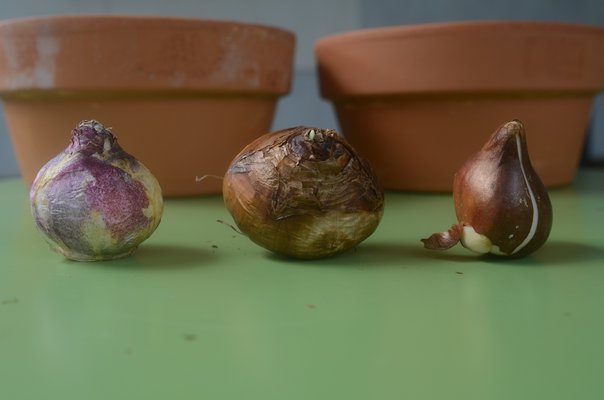
At this time of the year, many gardeners are just plain burned out.
The hot-then-wet summer, the slugs, the bugs, the weeds—they all take a toll. It can be hard to look ahead and try to plan new projects, let alone contemplate next year’s garden.
But well before next year’s annuals are planted and the bare-root perennials arrive on the doorstep, in the dead of the winter of 2012, wouldn’t you like to look out at the snow-covered landscape as you sit indoors smelling the hyacinths, daffodils and tulips blooming away on the dinning room table with their wondrous colors and promise of spring? Remember last winter?
If you’ve ever wanted to force spring flowering bulbs and have them bloom on demand next winter, then now is the time to take action. Bulbs for forcing need to be potted up now, or arrangements need to be made with your garden center so that the bulbs are either shipped to you or available for pick up in the next week or two. If you wait longer, then you’ll be disappointed at the selection available. But by getting the work done now you have the choice of colors, sizes and varieties.
In previous years we’ve ordered our bulbs by late August and received them in mid- to late October. But other arrangements can usually be made with suppliers or garden centers. Close to perfect timing is important since most bulbs that are forced (and not all can be) need from 12 to 16 weeks of cool temperatures to get blooms from February through April. Bulbs potted up in mid-October can be timed to bloom from mid-January right through early March.
There are plenty of intimidating articles and even books and precise growing guides on how to pot the bulbs. Instructions include cooling them to one temperature and then another and yet another, then covering them with sand, and finally a regime of raising-temperature exposures that will result in blooms when you want them. Well, if you want to have your tulips blooming precisely on Valentine’s Day, you can follow those prescriptions. But if you simply want blooms around the middle of February or sometime in March, it’s real easy.
Pot up your bulbs no later than the end of October. Use clay pots since plastic pots retain too much moisture and encourage rot. The preferable pots are the kind called “bulb pans,” available from 8 to 12 inches in diameter, or pots which are very shallow (depth about half their diameter).
Standard pots can work but the increased depth can allow too much water in root zone, so shallow is better. If you are using old pots, wash them well to eliminate any possibility of mold or algae buildup.
No special soil is needed but soil from the outdoor garden should be avoided. There should be no problems with Pro-Mix right out of the bag, so long as you don’t get it dripping wet and keep it that way all winter. Any peat-lite potting mix will do but try to find one that doesn’t have any fertilizer in it or water-retaining crystals.
The bulbs are planted so that the nose or tip of the bulb is just a quarter to a half inch below the top of the soil. It takes a little practice to get the right amount of soil under the bulbs, around them and on top of them but after a pot or two you’ll catch on real quick. You may want to take a dry run using a pot and some dry soil and the appropriate number of bulbs before you moisten the soil. This practice will allow you to space the bulbs, get them to the right level and fill in the voids with the soil.
Once you’ve got it right, use lukewarm water to moisten the soil and set the bulbs in their beds.
With tulips you’ll notice that the bulb has a flat side and a rounded side. The flat side should face outward. But with hyacinths and others, it doesn’t matter.
A 10-inch pot is probably the most popular. And as a rule of thumb for tulips and daffodils, try to get in one bulb for each inch of pot diameter and space them evenly around the pot. So an 8-inch diameter pot can have eight or so bulbs, but if the pot is deeper you can layer the bulbs and get nearly twice that number in.
Hyacinths are spaced at about half this rate so we try to squeeze five into a 10-inch pot. You can get a dozen scilla, muscari or iris reticulata into the same-size pot.
Next week, the steps to take and how to do the chilling process, the forcing and some varieties that I’ve had good success with. For those who want to jump right in take a look, visit extension.missouri.edu/p/G6550, then check back next week for more. Keep growing.